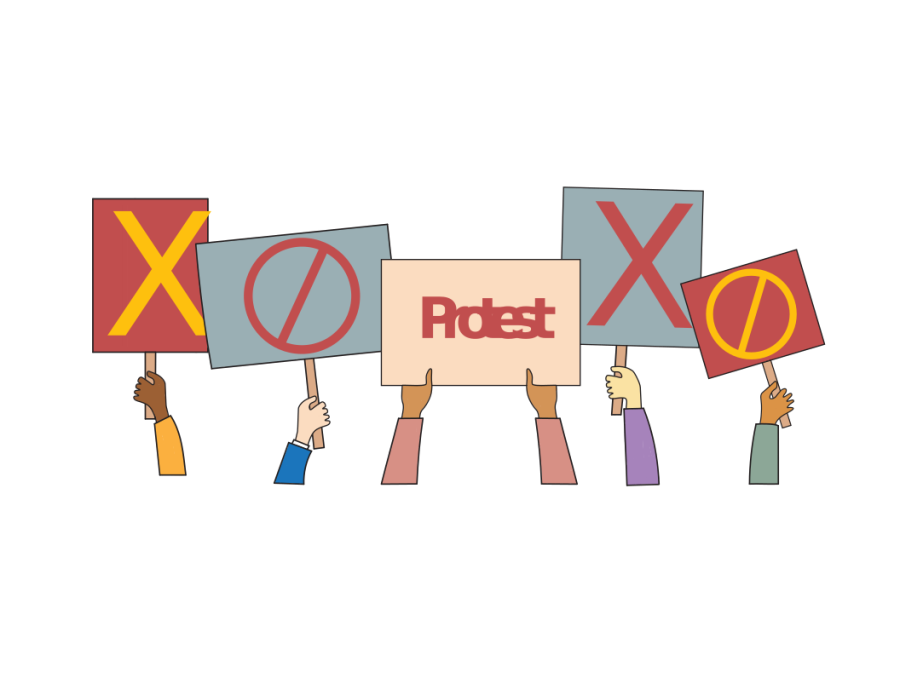Editorial: Protest Productivity Plateaus
Effectiveness of Large Demonstrations Dwindles
December 19, 2022
On May 25, 2020, the entirety of the nation was seized with terror and petrification over a nine minute, twenty-nine second video. It popped up on every Instagram story; the news headlines flashed red and blue with details of the egregious case, and TikTok videos almost immediately began circulating about the injustice that had led to a man’s passing. The death of George Perry Floyd Jr. set into motion a domino-like sequence of events, which would result in reform in police departments across the country, further intensifying the partisan divide, and most importantly, igniting wide-scale protests which took the nation by storm.
The protests started the day after Floyd’s death, and, according to the New York Times, peaked on June 6, 2020 with 550 cities across the U.S. being host to protests — some peaceful, some violent. According to the Carr Center for human rights, over the duration of the protests, somewhere from 15 million to 26 million Americans were engaged in the cause. Changes began to occur nationwide. According to Urban Institute, many communities reduced police funding and reallocated that money towards supports for mental health and social services. However, these advances eventually plateaued, as did the protests. The issue of police brutality continued, and in the grand scheme of things, the developments made due to protests were infinitesimal when backdropped against the severity of the issue. The cycle is recurrent. First, a devastating occurrence causes mass protest which causes companies and politicians to placate the public with small shifts in policy and eventually the uprisings die down. With every cycle, the issue changes, the year changes, but the outcome never does. It is because of the eventual downfall of the movement, that governments and corporations have learned that they do not truly have to change, and it is mostly because of this cycle that protests have lost a substantial amount of their impact.
However, the decline in the productivity of protests is not only due to people being appeased so easily but also because of demonstrations losing their credibility. The use of social media has allowed for uprisings to form rapidly and expand at a dangerous rate. According to the Marshall Project, the increasing danger and violence of revolts has also led to a decrease in willingness by the public to participate as well as a decrease in the police’s willingness to cooperate kindly with protesters. Additionally, more than a few protests have lost credibility due to acts of violence committed during the protests by people not even interested in the cause. For example, the few 2020 Black Lives Matter protests that turned violent due to participants who did not truly understand the purpose were used by politicians such as Donald Trump to invalidate the cause amongst their followings. Unfortunately, the invalidation was effective in convincing people that protests are inherently violent. The Armed Conflict Location & Event Data Project reported that 93% of these protests were peaceful, but 42% of respondents in a Morning Consult poll believed that “most protesters (associated with the BLM movement) are trying to incite violence or destroy property.”
Another sect of those not actually interested in the cause of the protests are performative activists, who have also caused a downturn in protest legitimacy. These people feign interest in issues for long enough to snap a picture, upload it to social media platforms, and then receive praise for their politically and socially aware actions. Then, they turn their backs and the number of demonstrators shrinks rapidly. The dwindling number of activists that remained a couple months after Floyd’s death served as proof to police departments and politicians that a substantial passion about this cause wasn’t held by many. Smaller demonstrations signaled that considerable change wasn’t needed anymore, as the size of protesting groups weren’t threatening the government’s authority as much as previously.
However, there has been a positive side to the amount of social media posts that are uploaded — awareness. Posts have been successful in boosting morale and inspiring new fights, as well as bringing notice to charities and places to donate to support movements. Large numbers are one of the most important components to a protest’s success. In fact, according to BBC Future, nonviolent protests that engage 3.5% of the world’s population have never failed to achieve their cause. The protests that meet this quota are twice as likely to succeed as violent or armed protests. The pressure that large amounts of truly interested and willing-to-fight people can put on governments is far greater than any violent rebellion could ever cause, and social media can draw people to care about and consider causes like nothing else can.
As governments adapt and become more comfortable with protests, new ways of bringing attention to a cause need to be developed. Writing to public officials, engaging with candidates for office and local governmental figures, or boycotts could be effective ways to make the same impact, but avoid the issues of violence and performativity. No matter what the new method be, it needs to draw large swaths of people and capture the eye of higher-ups. No change can happen without persistence.


